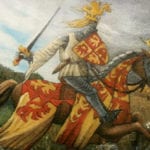 Miscellaneous
Miscellaneous  Miscellaneous
Miscellaneous  Gaming
Gaming 10 Funny Tutorials in Games
 History
History 10 Fascinating Little-Known Events in Mexican History
 Facts
Facts 10 Things You May Not Know about the Statue of Liberty
 Movies and TV
Movies and TV 10 Movie Adaptions That Brought Popular Songs to Life
 Health
Health 10 Miraculous Advances Toward Curing Incurable Diseases
 Miscellaneous
Miscellaneous 10 Undeniable Signs That People’s Views of Mushrooms Are Changing
 Animals
Animals 10 Strange Attempts to Smuggle Animals
 Travel
Travel 10 Natural Rock Formations That Will Make You Do a Double Take
 Movies and TV
Movies and TV 10 Actors Hidden in Your Favorite Movies
 Miscellaneous
Miscellaneous 10 Interesting Things Manufacturers Stopped Making and Why
 Gaming
Gaming 10 Funny Tutorials in Games
 History
History 10 Fascinating Little-Known Events in Mexican History
Who's Behind Listverse?

Jamie Frater
Head Editor
Jamie founded Listverse due to an insatiable desire to share fascinating, obscure, and bizarre facts. He has been a guest speaker on numerous national radio and television stations and is a five time published author.
More About Us Facts
Facts 10 Things You May Not Know about the Statue of Liberty
 Movies and TV
Movies and TV 10 Movie Adaptions That Brought Popular Songs to Life
 Health
Health 10 Miraculous Advances Toward Curing Incurable Diseases
 Miscellaneous
Miscellaneous 10 Undeniable Signs That People’s Views of Mushrooms Are Changing
 Animals
Animals 10 Strange Attempts to Smuggle Animals
 Travel
Travel 10 Natural Rock Formations That Will Make You Do a Double Take
 Movies and TV
Movies and TV 10 Actors Hidden in Your Favorite Movies
Top 10 Facets Of Modern Life Which Appeared In 1700s Britain
The Victorian age was the birthplace of many things we take for granted today. From refrigeration to wristwatches, many technologies that laid the foundation of modern society were developed over the course of the 1800s. Or at least, that’s what most of us have been taught.
Of course, the 1800s were undoubtedly an age of unprecedented progress and innovation. But many areas of modern life, from the technology we use to the ways we behave, first appeared in Britain in the 1700s.
That century, which laid the groundwork for the global industrial revolution which was to follow, was just as important in the history of the modern world as the Victorian age that followed it. With that in mind, we’ll shed some light on 10 facets of modern life which first developed in Britain in the 1700s.
10 Retail Therapy
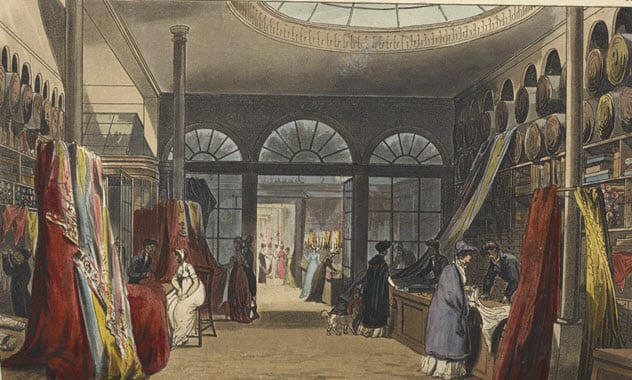
In our busy, chaotic modern lives, many of us find solace in spending a day wandering the high street. Even if we don’t buy anything, we find that taking the time to browse the shops relaxes us and makes us feel better about ourselves. You might think that this materialistic way of passing the time must be a modern phenomenon, but it actually has its roots in the 1700s.
Over the course of the 18th century, cities in Britain grew rapidly. This growth was triggered by the flourishing economic wealth of urban areas, which created skilled jobs and helped foster a burgeoning middle class. More people had more money than ever before, and soon, the bustling marketplace was replaced by the flashy high street.[1]
Shopping became a much more luxurious affair, done for pleasure as much as necessity. In wealthier town centers, it became taboo to even discuss prices or the exchange of money in shops.
The wealthiest were expected to know the prices of most things before they bought or to have so much money that they didn’t care about the price. The details would often be hashed out at a later date to prevent potential embarrassment.
Shopkeepers quickly learned the importance of advertising. Many put a great deal of effort into building elaborate window displays to tempt casual shoppers inside. In a world increasingly dominated by people who could read, they grasped the opportunity presented by the printing revolution and started advertising with fliers, posters, and newspapers. This practice soon spread across the world.
9 Libraries
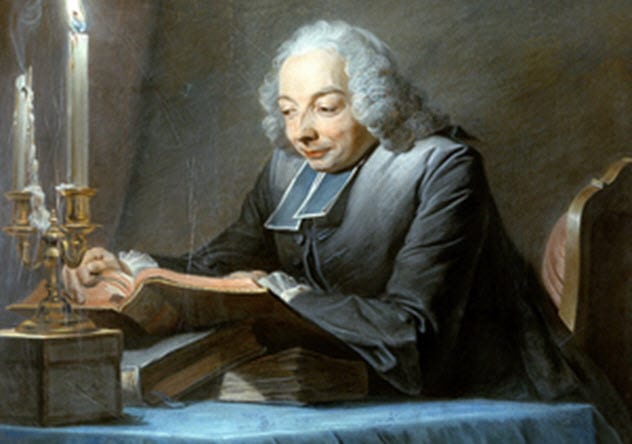
The Enlightenment led to a shift in European society. People became less interested in an individual’s background and wealth and more interested in their intellectual ability.
Knowledge, learning, and reasoning became highly valued traits, and people became keener to explore history and the sciences. As part of this social shift, libraries became increasingly common.
These libraries were still much different than the ones we are familiar with today. For one thing, they hardly ever contained works of fiction unless the fiction served some kind of moral or intellectual purpose. This was because libraries were still viewed as places of education and learning, the place where people went for reference in the age before the rise of the Internet.
Before the 1700s, most libraries were privately owned and only open to a select few individuals. This changed over the course of the century. Many people of lesser means grouped their money together and bought communal books, which they then circulated among themselves.[2]
As these private readers’ clubs grew, the biggest began storing their books in central locations and charging new people a membership fee to join. This was how most libraries before the Victorian age operated.
These organizations grew along with the public’s interest in reading, and many, particularly those associated with universities, began offering academics and students free access. These groups became known as subscription libraries—open to all who could afford the admission fee.
By 1850, England and Scotland boasted roughly 500 subscription libraries between them, enough to cover a considerable portion of the population.
8 Office Blocks
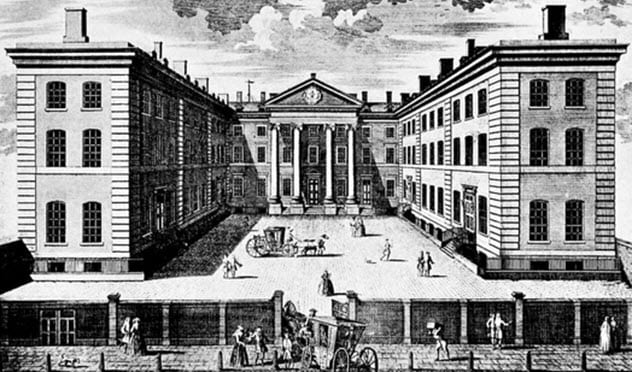
Nothing symbolizes modern urban life better than the soaring office blocks which dominate our city skylines. While the modern mazes of cubicles, computers, and wastepaper bins might look incredibly different than any building in the 1700s, the first office block of the modern age was built in London in 1726: The Old Admiralty Office.[3]
The burgeoning British Empire had become wrapped up in increasingly detailed and complicated bureaucracy, so the government constructed a purpose-built home for the navy to manage its paperwork and organize meetings. More government office buildings appeared across Westminster over the course of the century.
East India House, the central offices of the East India Company, was rebuilt in 1729. Over the course of the century, it grew to become one of the most important centers of administration in the world as the company governed India as one of its possessions.
Charles Lamb, who worked as a clerk at the office for 30 years, described it as “light-exuding, pent-up offices, where candles for one-half the year supplied the place of the Sun’s light.” Not too dissimilar to some offices around the world today.
7 Tea And Coffee Culture
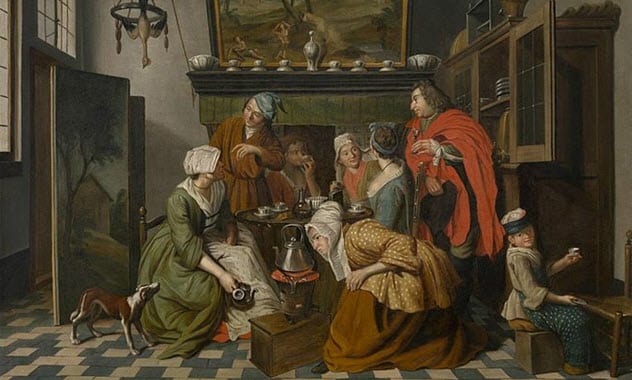
In medieval times, alcohol was the drink of choice to get people through the working day. Nowadays, however, many of us rely on coffee and tea. This fundamental switch—from a depressant to a stimulant—has often been posited as one of the key factors behind the increase in productivity that occurred in the West during the early modern era.
Although the Portuguese and Dutch were among the first Europeans to trade tea and coffee with the East, these products were usually only available to the wealthy elite. It was in Britain that the now-global coffeehouse culture started. By the time the first coffeehouses opened in Paris (1672) and Boston (1676), there were already around 3,000 coffeehouses across the UK.[4]
These coffeehouses effectively replaced alehouses as public meeting places. Any man, regardless of wealth, was allowed to attend the coffeehouse if he could pay the one penny entry fee. Coffeehouses were often places of raucous debate, public lectures, and stock market trade, earning them the nickname “penny universities.”
They were a staple of individual liberty. The monarchy tried to stamp them out several times over the course of their history because they had a tendency to encourage free thought. Crucially, however, they also provided a steady supply of ready, hot coffee and tea for any who visited.
As a result, over the course of the 1700s, coffee—and especially tea—replaced alcohol as the drink of choice for the average person. As the British sugar trade was also flourishing at the time, they frequently added sugar and milk to their drinks.
The habit of people from all social classes drinking hot drinks slowly spread across the world, especially in the Victorian era, and is a fundamental part of the culture of many Western countries today.
6 First Newspapers
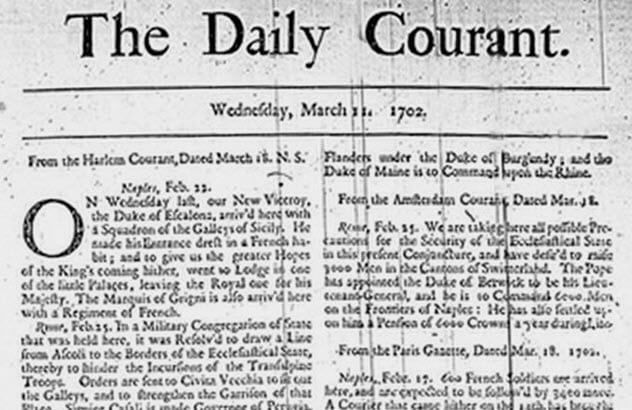
After the invention of the printing press during the Renaissance, printed broadsheets, pamphlets, and even magazines spread across most of Europe. The proliferation of literature in Germany and Britain inspired the common people to take political stances in the Thirty Years’ War and the English Civil War, respectively. But it was still some time before the first newspaper as we would recognize it appeared.
The press was restricted across Europe in the first few years of its existence. Advertising was forbidden, and publishers who espoused any kind of political stance were at risk of being punished or closed down.
In Britain, the press was strictly limited by the Licensing Act, but newspapers prospered after the act lapsed in 1695. One of the first papers to capitalize on this was The Daily Courant, often considered to be the world’s first successful daily newspaper. It was one of the first newspapers to be supported by advertisements.[5]
The press expanded rapidly. By 1720, there were dozens of independent, regular newspapers being published across Britain. The common man in Britain had surprisingly easy access to newspapers because many coffeehouses and public houses subscribed to at least one newspaper. This would then be free for guests to read—as long as they didn’t take it away with them.
5 Raw Fruit

While many parts of life in the 1700s seem remarkably similar to modern life, their diet was extremely different. The difficulties of preservation made fresh fruit and vegetables difficult to access for the increasingly large urban population. Fresh meat was also hard to find, so the vast majority of it was either dried or salted.
Most people subsisted on a diet of cheese, bread, pies, and stews. Doctors and generally health-conscious people at the time were actually suspicious of raw vegetables and especially raw fruit, which they believed could cause everything from indigestion to plague.
This changed when James Lind published his A Treatise Of The Scurvy in 1753. It provided the first proof that citrus fruit could prevent and treat scurvy. After trying everything from vegetable soups to vinegar and mustard, the British Royal Navy settled on lemon and lime juice. By 1795, they were frequently using citrus to combat the symptoms of scurvy and were the first nation to do so.[6]
This helped to dispel the myth that raw fruit and vegetables were unhealthy. Raw fruit gradually came to be accepted by the general population, and before long, experiments began to make the production of fruit more efficient.
Conducted by Thomas Andrew Knight in 1790, the first apple hybridization process was widely thought to be the first example of artificially altering the structure of a plant. The Royal Horticultural Society was established solely for the study and promotion of plants in 1804.
4 Copyright
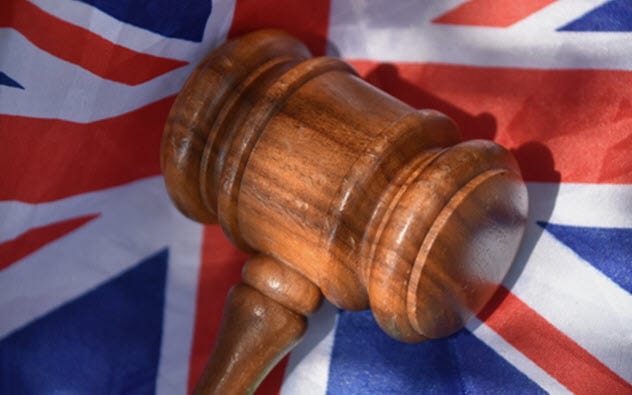 Copyright is everywhere today. We see dozens, if not hundreds, of copyrighted and trademarked materials each day without thinking about them—everything from logos to fonts to phrases have been claimed by individuals and companies as intellectual property.
Copyright is everywhere today. We see dozens, if not hundreds, of copyrighted and trademarked materials each day without thinking about them—everything from logos to fonts to phrases have been claimed by individuals and companies as intellectual property.
If we ask the average person what a copyright or trademark is, they would probably point to something iconic like a famous fast-food logo or a brand of designer clothing. But the history of copyright actually started with publishing long ago.
Traditionally, authors and writers were supported by patronage. Wealthy individuals—and sometimes, the government—would provide money and other services to writers they liked or respected to support their livelihoods.
By the 1700s, however, this practice was dying and authors had to find a new form of protection. To prevent authors and publishers from being taken advantage of, the British Parliament passed the Copyright Act 1709. In the Act’s own words:
Printers, Booksellers, and other Persons, have of late frequently taken the Liberty of Printing, Reprinting, and Publishing . . . Books, and other Writings, without the Consent of the Authors or Proprietors of such Books and Writings, to their very great Detriment, and too often to the Ruin of them and their Families.[7]
The Act was the very first of its kind, and it preserved the copyright of all books published after 1710 for 14 years. If the author was still alive at the end of the 14 years, the copyright was renewed. If not, the work passed into the public domain.
3 Rise Of Cookbooks
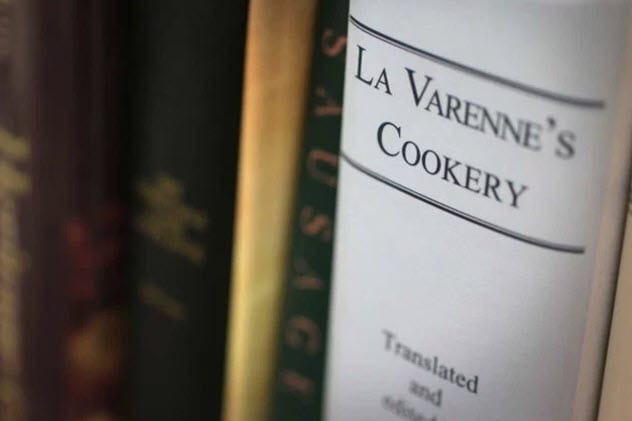
For most of history, cookbooks and recipe books were produced for a very particular demographic: professional cooks. These men and women were employed by the wealthy to cook food for them, their families, and their guests. The oldest cookbooks in existence, dating to the Middle Ages, were nearly all written specifically for cooks in the royal household.
Over the course of the 18th century, however, more and more common people learned how to read. By the end of the century, it is estimated that around 63 percent of the British population was literate. At the same time, printing technology advanced and books became cheaper. This led to the rise of the common cookbook as we know it today.
The first modern cookbook was published in London in 1708 and had the catchy title of England’s Newest Way in all Sorts of Cookery, Pastry, and All Pickles that are fit to be used. It was written by Henry Howard, a professional cook who had worked for nobility.
But it contained guidance on cooking all manner of things—from biscuits to everyday meals—and was clearly aimed at a general audience. In the preface, he wrote that his goal was to help “those that are curious in the necessary and commendable art of cookery.”[8]
It was exceedingly popular and had four editions in two decades. Over the course of the century, dozens more recipe books were published. They were aimed at everyone from the experienced cook to young virgins who were expected to learn the very basics of housekeeping for their future husbands.
Cookbooks steadily grew in popularity and eventually crossed to America. There, the first cookbook, American Cookery, was published in 1796.
2 Toll Roads
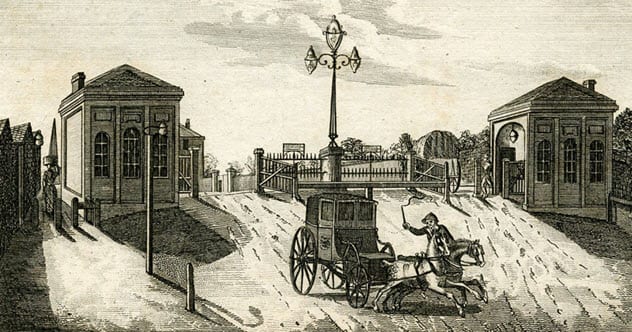
One of our least favorite things about modern life is the existence of toll roads. More common in some countries than others, toll roads often exist in hard-to-reach places where the only alternative to the expensive road is to spend a long time traveling down poorly maintained and sometimes private roads.
Other times, they are a way for those who are willing to pay to dodge congested roads near large population centers. An example is the M6 Toll Road near Birmingham in the UK.
Toll roads may be hated today, but they played an essential role in the birth of modern road infrastructure in early modern England. In medieval times, it was the responsibility of each individual to maintain the road in front of his property.
By the 1600s, however, the country’s roads had fallen into disrepair and were clearly in need of improvement. The government passed the first Turnpike Act in 1707. This allowed a private company to maintain a stretch of road and charge tolls on it as long as they kept the roads in good repair.
By 1750, there were over 100 private road maintenance companies, known as turnpike trusts, across the UK. The government passed laws which the turnpike trusts had to enforce, such as placing road signs showing distances to nearby towns and driving on the left side of the road.
The turnpikes led to a very simple “rules of the road” situation which became the predecessor of our modern laws today. The tolls raised by these turnpike trusts were used to pay people to enforce these rules as well as to compensate contractors for maintaining, planning, and building roads.[9]
By 1776, there were over 500 turnpike trusts and most of the country’s main roads were looked after by turnpike trusts.
1 Engines
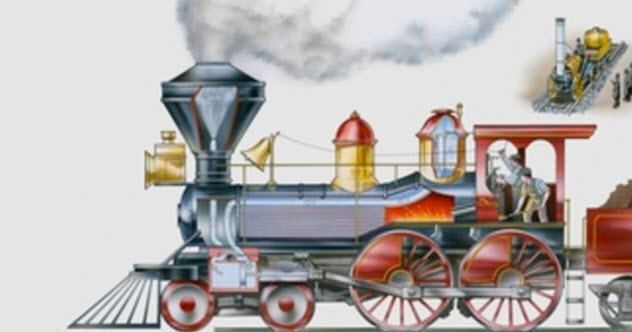
The modern world wouldn’t exist without engines. They drive everything from our power stations to our cars. It’s difficult to imagine how modern life would be the same in any way without engines. Without them, we’d have no way to generate a stable supply of electricity.
Although the ancient Greeks developed mechanical devices that could be considered engines today, they were too weak to serve any practical purpose and were used solely to impress visitors or to teach physics to students. The first engine to be put to practical use was the atmospheric steam engine devised by Thomas Newcomen in 1712.
While rather limited in its practical applications, it was primarily used for assisting with mining work. Hundreds of them were built across Britain and eventually Europe over the course of the 18th century. Most were employed in draining water from mineshafts.[10]
The engine was further refined by James Watt, whose steam engine was roughly twice as efficient. His design, which he refined over the course of the 1770s, could power industrial machines without reliance on horses or water, as mills were at the time.
This freed British industry from geographical constraints, fostering the manufacturing boom that first spread across Britain and then the world. We now know this as the industrial revolution.
To find out the surprising ways that ancient Egyptians influenced our modern life, check out 10 Modern Things Ancient Egyptians Secretly Created and 10 Ways Ancient Egyptians Influenced Modern Life.








